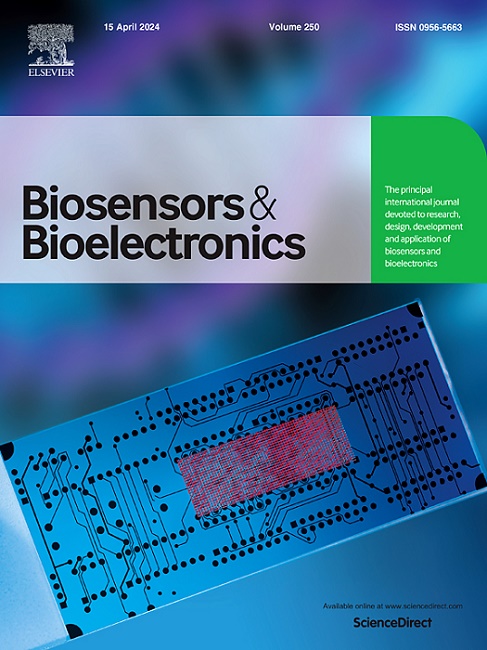昆虫气味结合蛋白修饰的生物传感器用于敏感和特异的醇类电化学检测
IF 10.5
1区 生物学
Q1 BIOPHYSICS
引用次数: 0
摘要
嗅觉生物传感器在挥发性有机化合物(VOCs)的检测中发挥着重要作用,但生物传感器对不同醇类的响应模式及其差异的潜在原因尚不清楚。本研究利用果蝇气味结合蛋白(Drosophila odorant-binding protein, LUSH)作为传感材料,设计了一种灵敏的电化学嗅觉生物传感器,用于检测11种不同分子结构(烷基链长、羟基数、环醇)和苯酚。用原子力显微镜(AFM)、电化学阻抗谱(EIS)和循环伏安法(CV)对LUSH蛋白共价固定的电极进行了表征,并通过电化学阻抗谱(EIS)考察了它们对醇类化合物的检测能力。结果表明,LUSH改性生物传感器对多种醇具有超灵敏的检测效果(检出限为10 ~ 100 fM),线性范围为10 ~ 14 ~ 10 ~ 7 M,检测系数(R2)为0.948 ~ 0.992。此外,该生物传感器对干扰物具有较高的选择性(选择性系数<;0.22),重复性好(相对标准偏差,RSD: 1.2%,并联传感器n = 4),稳定性好(第10天响应降低10.2%)。值得注意的是,生物传感器对醇类化合物的敏感性表现出正醇类化合物的烷基链长度依赖性,并受羟基数目和环结构的影响。更重要的是,分子对接揭示了lush -醇相互作用的结合模式、结合能和关键氨基酸,并解释了响应差异。本文章由计算机程序翻译,如有差异,请以英文原文为准。
Insect odorant-binding protein modified biosensor for sensitive and specific electrochemical detection of alcohols
Olfaction biosensors are playing crucial roles in detecting volatile organic compounds (VOCs) in various domains, while the response pattern of biosensors to different alcohols and the underlying reasons for the differences in response remain unclear. Herein, this study presents a sensitive electrochemical olfactory biosensor utilizing Drosophila odorant-binding protein (LUSH) as a sensing material for the detection of 11 alcohols with different molecular structures (alkyl chain lengths, hydroxyl group numbers, and cyclic alcohols) and phenol. The electrodes covalently immobilized with the LUSH proteins were characterized by atomic force microscopy (AFM), electrochemical impedance spectroscopy (EIS), and cyclic voltammetry (CV), and their ability to detect alcohols was investigated through EIS. Results showed that the LUSH modified biosensor exhibited ultrasensitive detection of multiple alcohols (detection limits: 10–100 fM), with linear ranges from 10-14 to 10-7 M and coefficients of determination (R2) of 0.948–0.992. In addition, the biosensor demonstrated high selectivity toward interfering compounds (selectivity coefficients <0.22), excellent reproducibility (relative standard deviation, RSD: 1.2%, n = 4 for parallel sensors), and good stability (response decreased by 10.2% on the 10th day). Notably, the sensitivity of the biosensor to alcohols showed alkyl chain-length dependence of n-alcohols and was influenced by the number of hydroxyl groups and the cyclic structure. More importantly, molecular docking revealed the binding modes, binding energies, and key amino acids involved in the LUSH-alcohol interaction and explained the response discrepancies.
求助全文
通过发布文献求助,成功后即可免费获取论文全文。
去求助
来源期刊

Biosensors and Bioelectronics
工程技术-电化学
CiteScore
20.80
自引率
7.10%
发文量
1006
审稿时长
29 days
期刊介绍:
Biosensors & Bioelectronics, along with its open access companion journal Biosensors & Bioelectronics: X, is the leading international publication in the field of biosensors and bioelectronics. It covers research, design, development, and application of biosensors, which are analytical devices incorporating biological materials with physicochemical transducers. These devices, including sensors, DNA chips, electronic noses, and lab-on-a-chip, produce digital signals proportional to specific analytes. Examples include immunosensors and enzyme-based biosensors, applied in various fields such as medicine, environmental monitoring, and food industry. The journal also focuses on molecular and supramolecular structures for enhancing device performance.
 求助内容:
求助内容: 应助结果提醒方式:
应助结果提醒方式:


